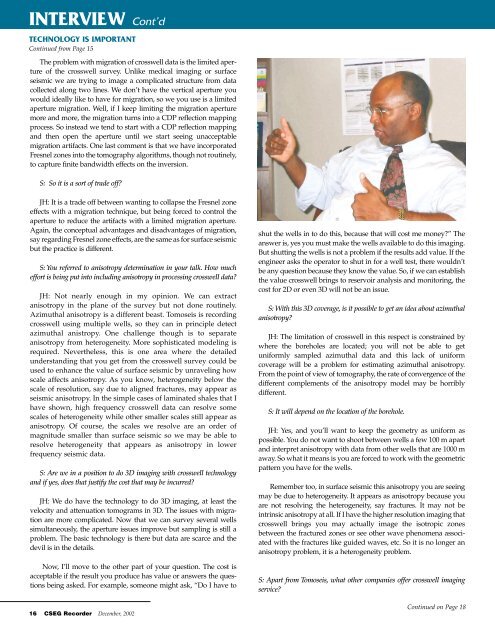An interview with Jerry Harris - Stanford University
An interview with Jerry Harris - Stanford University
An interview with Jerry Harris - Stanford University
Create successful ePaper yourself
Turn your PDF publications into a flip-book with our unique Google optimized e-Paper software.
INTERVIEW Cont’d<br />
TECHNOLOGY IS IMPORTANT<br />
Continued from Page 15<br />
The problem <strong>with</strong> migration of crosswell data is the limited aperture<br />
of the crosswell survey. Unlike medical imaging or surface<br />
seismic we are trying to image a complicated structure from data<br />
collected along two lines. We don’t have the vertical aperture you<br />
would ideally like to have for migration, so we you use is a limited<br />
aperture migration. Well, if I keep limiting the migration aperture<br />
more and more, the migration turns into a CDP reflection mapping<br />
process. So instead we tend to start <strong>with</strong> a CDP reflection mapping<br />
and then open the aperture until we start seeing unacceptable<br />
migration artifacts. One last comment is that we have incorporated<br />
Fresnel zones into the tomography algorithms, though not routinely,<br />
to capture finite bandwidth effects on the inversion.<br />
S: So it is a sort of trade off?<br />
JH: It is a trade off between wanting to collapse the Fresnel zone<br />
effects <strong>with</strong> a migration technique, but being forced to control the<br />
aperture to reduce the artifacts <strong>with</strong> a limited migration aperture.<br />
Again, the conceptual advantages and disadvantages of migration,<br />
say regarding Fresnel zone effects, are the same as for surface seismic<br />
but the practice is different.<br />
S: You referred to anisotropy determination in your talk. How much<br />
effort is being put into including anisotropy in processing crosswell data?<br />
JH: Not nearly enough in my opinion. We can extract<br />
anisotropy in the plane of the survey but not done routinely.<br />
Azimuthal anisotropy is a different beast. Tomoseis is recording<br />
crosswell using multiple wells, so they can in principle detect<br />
azimuthal anistropy. One challenge though is to separate<br />
anisotropy from heterogeneity. More sophisticated modeling is<br />
required. Nevertheless, this is one area where the detailed<br />
understanding that you get from the crosswell survey could be<br />
used to enhance the value of surface seismic by unraveling how<br />
scale affects anisotropy. As you know, heterogeneity below the<br />
scale of resolution, say due to aligned fractures, may appear as<br />
seismic anisotropy. In the simple cases of laminated shales that I<br />
have shown, high frequency crosswell data can resolve some<br />
scales of heterogeneity while other smaller scales still appear as<br />
anisotropy. Of course, the scales we resolve are an order of<br />
magnitude smaller than surface seismic so we may be able to<br />
resolve heterogeneity that appears as anisotropy in lower<br />
frequency seismic data.<br />
S: Are we in a position to do 3D imaging <strong>with</strong> crosswell technology<br />
and if yes, does that justify the cost that may be incurred?<br />
JH: We do have the technology to do 3D imaging, at least the<br />
velocity and attenuation tomograms in 3D. The issues <strong>with</strong> migration<br />
are more complicated. Now that we can survey several wells<br />
simultaneously, the aperture issues improve but sampling is still a<br />
problem. The basic technology is there but data are scarce and the<br />
devil is in the details.<br />
Now, I’ll move to the other part of your question. The cost is<br />
acceptable if the result you produce has value or answers the questions<br />
being asked. For example, someone might ask, “Do I have to<br />
16 CSEG Recorder December, 2002<br />
shut the wells in to do this, because that will cost me money?” The<br />
answer is, yes you must make the wells available to do this imaging.<br />
But shutting the wells is not a problem if the results add value. If the<br />
engineer asks the operator to shut in for a well test, there wouldn’t<br />
be any question because they know the value. So, if we can establish<br />
the value crosswell brings to reservoir analysis and monitoring, the<br />
cost for 2D or even 3D will not be an issue.<br />
S: With this 3D coverage, is it possible to get an idea about azimuthal<br />
anisotropy?<br />
JH: The limitation of crosswell in this respect is constrained by<br />
where the boreholes are located; you will not be able to get<br />
uniformly sampled azimuthal data and this lack of uniform<br />
coverage will be a problem for estimating azimuthal anisotropy.<br />
From the point of view of tomography, the rate of convergence of the<br />
different complements of the anisotropy model may be horribly<br />
different.<br />
S: It will depend on the location of the borehole.<br />
JH: Yes, and you’ll want to keep the geometry as uniform as<br />
possible. You do not want to shoot between wells a few 100 m apart<br />
and interpret anisotropy <strong>with</strong> data from other wells that are 1000 m<br />
away. So what it means is you are forced to work <strong>with</strong> the geometric<br />
pattern you have for the wells.<br />
Remember too, in surface seismic this anisotropy you are seeing<br />
may be due to heterogeneity. It appears as anisotropy because you<br />
are not resolving the heterogeneity, say fractures. It may not be<br />
intrinsic anisotropy at all. If I have the higher resolution imaging that<br />
crosswell brings you may actually image the isotropic zones<br />
between the fractured zones or see other wave phenomena associated<br />
<strong>with</strong> the fractures like guided waves, etc. So it is no longer an<br />
anisotropy problem, it is a heterogeneity problem.<br />
S: Apart from Tomoseis, what other companies offer crosswell imaging<br />
service?<br />
Continued on Page 18

















